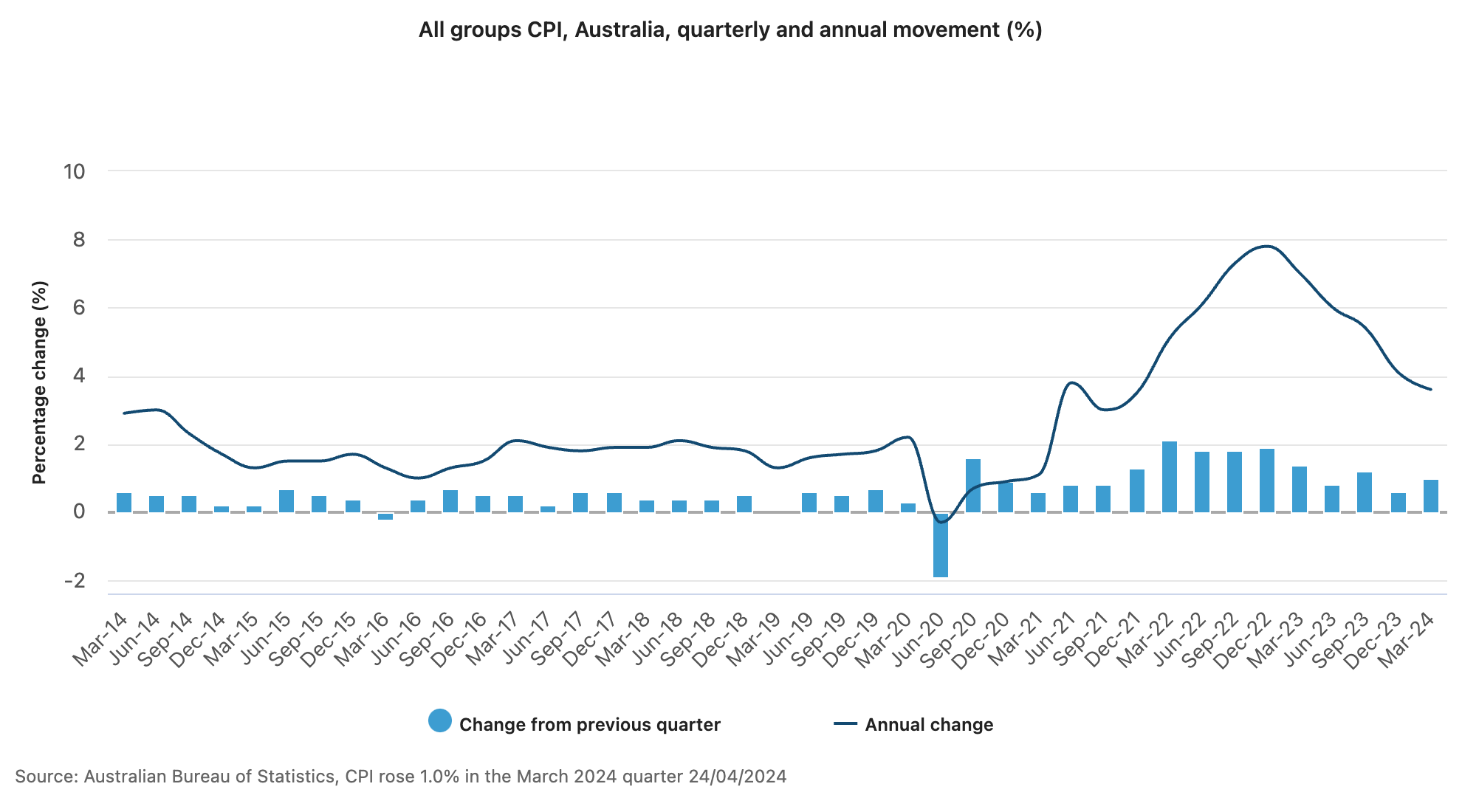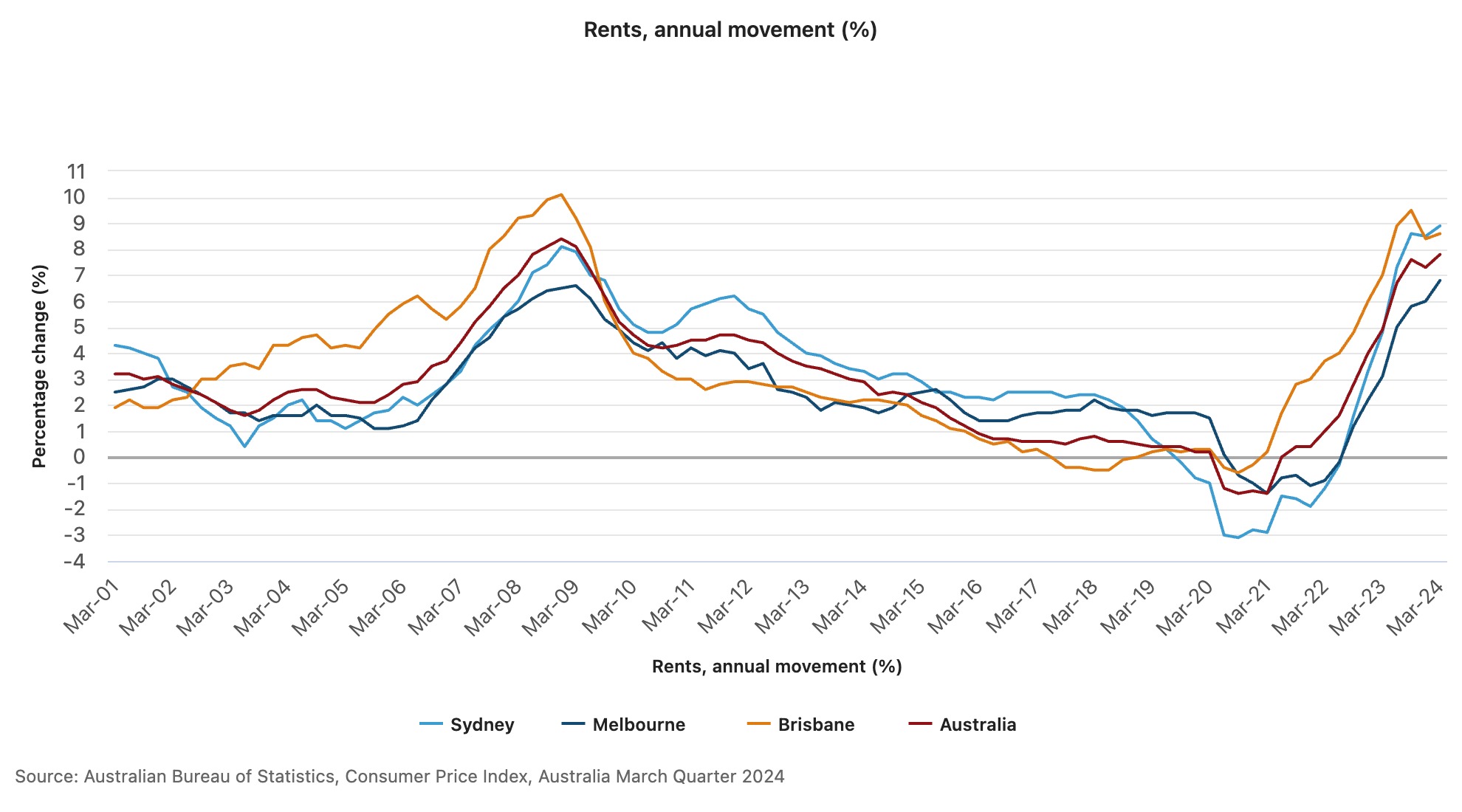Australian inflation was hotter than expected. Here's why
After all, we're now seeing what markets can do when central banks (i.e. the Fed) signal rate cuts too early.
After today's numbers, the RBA may well be vindicated for keeping its options open. Headline and trimmed mean inflation all came in above economists' expectations. Here are the key numbers:
| Q1 2024 | Q4 2023 | Market Consensus | |
| Headline (y/y) | +3.6% | +4.1% |
+3.5% |
| Trimmed mean (q/q) | +1% | +0.8% | +0.9% |
| Trimmed mean (y/y) | +4% | +4.2% | +3.9% |
Source: ABS, Bloomberg
In this wire, we'll break down the key takeaways from a quarterly inflation print that has caused markets to lose its steam ahead of an (effective) four-day weekend.
.png)
The weights are changing
As nerdy as this sounds, before we go into the granular details, we must first address the changes in weighting. Every year, the ABS re-evaluates the weightings of the various products inside the inflation report. The weightings are meant to reflect how Australians in the major five capital cities are choosing to allocate their expenditures.
While the data was changed (and released publicly) at the end of February, we are talking about this now because this is the first quarterly inflation report with the new weighting.
The most notable reductions are in alcohol and tobacco (-0.89%), home furnishings, and housing. Despite the reduction, housing will remain the biggest individual category in the CPI basket (something we'll talk about at length in the next section).
The most notable increases are in recreation and culture (+1.71%) and transport. The bulk of the increase in recreation and culture is coming from the huge surge in travel demand. International travel inflation fell by 6% in the quarter while domestic travel inflation rose 1.3% - but keep in mind that these numbers can obviously vary wildly quarter-to-quarter.
The big three remain the same: Construction, rents, utilities
Housing remains the biggest individual category, representing over one-fifth of the total composition of the report. As tends to be the case with housing, the biggest issues are:
- Construction costs - which reflect not just supply and demand but also how much it costs to pay the tradespeople who are building the homes,
- Rents - which demonstrate just how tight the rental market in the capital cities is, and
- Utilities - a function of whether the government's cost of living relief is genuinely working.
National rental price growth remains the highest since 2009, clocking in at +7.8% year-over-year.
%20(1).jpeg)
Electricity prices fell 1.7% over the quarter but that is only due to the Energy Bill Relief Fund. Year over year, the increase was 2% with the fiscal relief. Without government support, electricity prices would have increased 17% year-over-year.
Higher labour and material costs in the construction industry are reflected in the price increases for new dwellings. The 1.1% increase is slightly lower than the 1.5% rise in the December 2023 quarter but remains hot.
The other reason inflation came in hot - seasonality
Inflation also came in hotter than expected because of two things that re-rate every 12 months - the cost of your insurance and the cost of education.
- Insurance prices rose 16.4% annually, which is the strongest annual rise since 2001 and shows no signs of letting up.
- Education fees are up across the board, with the first quarter of 2024 showing the largest price increases in a single quarter since 2012.
Perhaps the rises in these two categories caused the marked decline in overseas travel! As the European strategist Andreas Steno Larsen once said, "go long what people need, short what people want".
What does this mean for the RBA?
While this print does show progress towards the RBA's goals, it's probably not the kind of progress it will be totally happy about. Coming into today's print, it was projecting 3.6% inflation by June and then a very slow path down to the 2-3% target band it uses. Today's figure, combined with the March Monthly CPI Indicator which also came in hotter than expected, a continuously tight labour market, and stalling economic growth, the RBA will still have an extremely tough balancing act ahead of itself.
Markets were forecasting just one rate cut over the next 18 months from the Reserve Bank. After today's print, that one rate cut will be delayed at best or disappear at worst. Questions will also likely be asked about whether the RBA will need to hike again - admitting it may have gone one too few in this cycle.
The next decision on interest rates is due May 7th. Here is a perfect X post from behavioural economist Evan Lucas to close this piece:

2 topics

